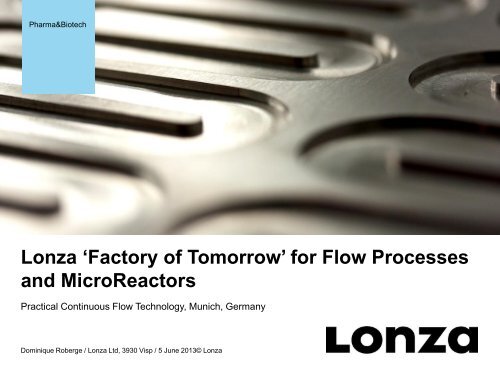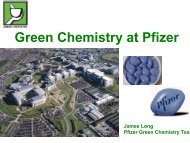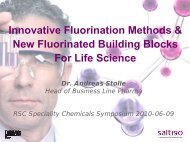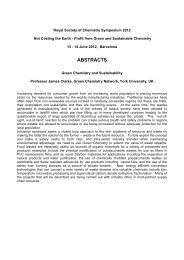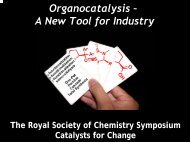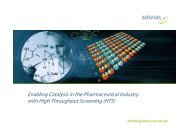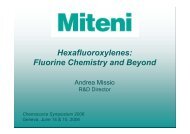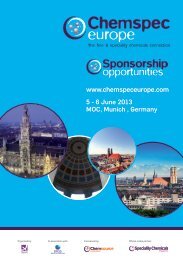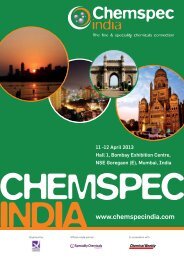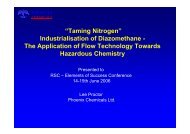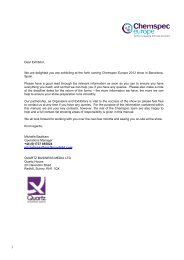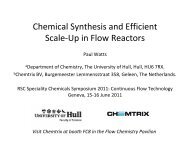Lonza 'Factory of Tomorrow' for Flow Processes ... - Chemspec Events
Lonza 'Factory of Tomorrow' for Flow Processes ... - Chemspec Events
Lonza 'Factory of Tomorrow' for Flow Processes ... - Chemspec Events
- No tags were found...
You also want an ePaper? Increase the reach of your titles
YUMPU automatically turns print PDFs into web optimized ePapers that Google loves.
Pharma&Biotech<strong>Lonza</strong> ‘Factory <strong>of</strong> Tomorrow’ <strong>for</strong> <strong>Flow</strong> <strong>Processes</strong>and MicroReactorsPractical Continuous <strong>Flow</strong> Technology, Munich, GermanyDominique Roberge / <strong>Lonza</strong> Ltd, 3930 Visp / 5 June 2013© <strong>Lonza</strong>
Re-design the Chemical Routes withthe Concept <strong>of</strong> Flash Chemistry in <strong>Flow</strong>Raw materials fromfine chemicalsSolventReagentSolventReagentSolventReagentInt. 1 Int. 2 Int. 3 APIStep 1Flash chemistry*Step 2 Step 3 Step 4• <strong>Flow</strong> <strong>Processes</strong> / Microreactors lead to drastic improvements• Excellent heat transfer & mixing• Exact control <strong>of</strong> residence time• Segregation <strong>of</strong> feeds, small volume, robust (pressure) etc.• Inherently Safer Design from the high level <strong>of</strong> confinement= Intensified Mini-Plant Concept* Flash chemistry concept see: Yoshida, J.-I. et al.,Chemistry – A European Journal 2008 (14) 74502Mai-13
Reaction Classification &AdvantagesType A reactions• Very fast (< 1 s)• Controlled by the mixing process• Increase yield through better mixing/heat exchangeType B reactions• Rapid reaction (10 s to 30 min)• Predominantly kinetically controlled• Avoid overcooking and increase yieldType C reactions• Slow reaction (> 30 min)• Batch processes with thermal hazard• Enhance safety• Need intensification3Mai-13
Microreactors Are at the Heart <strong>of</strong> aDramatic Shift in API ProductionIt enables continuous processes based on plug flow reactors withminimal volume <strong>of</strong> reagents, rapid dynamic responses androbustness, good temperature control, efficient mixing, etc.outlet coolinginlet coolingdelayloopoutlet productinlet fluid 1inlet fluid 2outlet coolinginlet cooling1 – 600 mL/min4May-13
Video <strong>of</strong> a Gas-liquid Type AReaction in the <strong>Flow</strong>Plate ® MicroReactor5May-13
Agenda• Reactor design <strong>for</strong> scale-up• Parallelization / Numbering-up illusionProcess intensification• Impact on production unit >> Factory <strong>of</strong> Tomorrow• Example 1. Organometallic reaction• Example 2. Azide chemistry6Mai-13
Grignard Reaction as a Test Reaction <strong>for</strong>Manifold & Heat Exchange Per<strong>for</strong>mancesOOOOOODimethyl oxalateCN 16543MW 118.09+Mg ClEthylmagnesium chlorideCN 38038MW 88.82OMg ClOO2-MOBCN 32182MW 116.12+OHO2-MOB_enolCN 32759MW 116.12RRT 1.17Feed-1: Dimethyloxalate (15 wt%), rest DMEFeed-2: Grignard (19 wt%), rest THFTemperature: -15°C, all feeds pre-cooledStoichiometry: Grignard / Dimethyloxalate = 1.15<strong>Flow</strong> rate: 40 g/min in total with1 or 4 injection points (Grignard)Roberge et al., Chem. Eng. Technol. 2008 (31) 1155 Barthe et al., Chem. Eng. Technol. 2008 (31) 11467May-13
Yield in area%Limitation <strong>of</strong> Pressure Driven Systems –Avoid Manifold / Parallelization10095908580Average = 84.4%Standard deviation = 0.13%Average = 84.0%Standard deviation = 0.09%7570656055With ManifoldWith Pumps and <strong>Flow</strong> ControllersAverage = 76.0%Standard deviation = 4.8%At ca 1.15 mol/mol500 10 20 30 40 50 60 70Time on stream [min]8May-13
Plate Size to DriveScale-up: <strong>Flow</strong>Plate ® MicroReactorsDevelopment Reactor• View the chemistry• Chemical systems aremetastable!• Test different structures• Ensure stoichiometryProduction Reactors• Design as a key ingredient toscale-up• Avoid parallelization• Enable Clean in Place• Multi-purpose & ready <strong>for</strong> cGMP<strong>Flow</strong>Plate ® LabChannel structurePlate Size: A6Plate Size: A5Roberge et al., Chemistry Today 2009 (27) 89Mai-13
As Small as Needed and Use“Micro” Where UsefulMulti-scale design to maximizeheat transfer and optimize mixingbut allowing variable residencetime modules > gain volume• Up to several hundreds <strong>of</strong> mL• seconds to minutes• Variable channel depth• to limit pressure dropCan be coupled with residencetime modules• Several liters• up to 30 minutes<strong>Flow</strong> rate from 15 to 600 mL/minNo internal parallelizationMicro dimension = 500 µmLarger dimension = 2 mm10Mai-13
Scale-up StrategyConventional Technology versus MRTMMRSInterfaceModulesMMRSApparatuses used at the early stage <strong>of</strong> processdevelopment need to have the potential <strong>for</strong> furtherscale-up.Production ScaleModules11May-13
Typical Projects in our PipelineProjects Formula P[bar]Test new technological approaches• Hydrogenation, Electro-dialysis, membranes, ozonolysis…T[°C]Project 1 Aggressive chemistry (corrosion!) 85 250Project 2 Organo-lithium reactions Normal -30Project 3 Fischer-Indole synthesis 20 170Project 4 Acid-catalyzed cyclization Normal -40Project 5 Nucleophilic substitution (Cl) 20 22012Mai-13
Example 1: <strong>Flow</strong>Plate ® MicroReactor toControl Reaction Heat2-Step Synthesis: Lithiation and Coupling+ +R1 H ( a c i d i c )Li R1 LiR1LiR3R2+ +OR1OR2R3LiSome Disadvantages• Plugging = <strong>Lonza</strong> patent applied Ultrasonic De-plugging SystemFirst reaction: Type A, highly exothermic (ΔTad > 75°C)• MicroreactorSecond reaction: Type B, exothermic (ΔTad < 25°C)• Static mixer under adiabatic conditions13Mai-13
Ultrasonic De-Plugging System• Optimize to use with the<strong>Flow</strong>Plate ® MicroReactors• Ultrasonic System to enablestable operations over days /weeks• Ultrasound is generated in theliquid > to create truecavitation• Optimal <strong>for</strong> spot plugging likein the mixing zone or exit• Imperative <strong>for</strong> organometallicreactions with BuLi14Mai-13
Microreactor Technology Leads toDramatic Process IntensificationsProcess intensification to enable inherently safer processesleading to a production paradigm• Lower reactor investment• Less manpower• Higher flexibility• Enhance safety• Faster change-over“Factory <strong>of</strong> tomorrow”250mL250L15Mai-13
Earlier Pilot Plant using MicroreactorTechnologyKey Features• Multi-purpose system• Modular• Hastelloy• T = -80 to +180°C• ATEX standards• Qualifiable <strong>for</strong> cGMP production• 3 dosage lines• 1 - 8 bar• 5 - 500 g/min (per line)Track record2 tons <strong>of</strong> isolated product20 m 3 processed fluid16Mai-13
Example 2: Azide Chemistry in MicroreactorsAzide-Nitrile Addition to make Tetrazole DerivativesTypical Type C reaction requiring several hoursThe mixture was heated under a N2 atmosphere at 100-105°C <strong>for</strong> 50 h• Segregation <strong>of</strong> Feeds: NaN 3 prepared in a special containment andprecisely mixed in the reactor avoiding batch bulk handling• Volume Minimization & Robustness: Reaction in flow per<strong>for</strong>med in10 min at 220°CGutmann et al., Angewandte Chemie International Edition 2010, DOI:10.100217Mai-13
The Future <strong>of</strong> <strong>Flow</strong> <strong>Processes</strong>:Full Integration <strong>of</strong> MRT in Production UnitsIn the past conventional means all batch processesProtection Li exchange Coupling Hydrolysis Extraction DistillationCentrifugeDryerCurrently the MR is used to increase reaction yield & safetyValue-addedin terms <strong>of</strong> YieldProtection Hydrolysis Extraction DistillationCentrifugeDryerFuture will lead to fully integrated flow processes: MR and more…Value-addedin terms <strong>of</strong> YieldProtectionflow reactorHydrolysisflow reactorContinuousextractionContinuousdistillationContinuousCentrifugeContinuousdryer18May-13
Reaction and Work UpIntegrated in One <strong>Flow</strong> UnitMini-Plant concept to enable New <strong>Processes</strong>and extend the design space <strong>of</strong> how weper<strong>for</strong>m chemistryKey Features• Microreactor <strong>for</strong> a flash reaction• CSTR <strong>for</strong> precipitation• High pressure valve• Filter to removal salt• Wiped film evaporator• Fraction collectorThroughput• More than 1 kg/day <strong>of</strong>product;distillation is limiting19Mai-13
<strong>Lonza</strong> “Factory <strong>of</strong> Tomorrow” <strong>for</strong>Continuous <strong>Flow</strong> / MRTAim: huge process intensification via flowCabin concept to enable high flexibility• Use <strong>of</strong> various equipment: microreactors, static mixers,extraction column, distillation (thin-wiped film, etc.)• Various flow rates, high pressures &temperature• Up to several tons• 100 bar – 300°C > hydrogenationThroughput• 900 mL 10 kg/day• 3600 mL 40 kg/dayFaster Scale-up and change-over• Non ATEX• New concept <strong>for</strong> cGMP qualification>> Overall goal is to reduce drasticallythe costs <strong>of</strong> goods20Mai-13
“Factory <strong>of</strong> Tomorrow”Head TanksBunkerAreaCabin <strong>for</strong> theintensified processAirlockTechnicalroomProduct21May-13
Economical Gain: Batch Versus <strong>Flow</strong>Example 1: Process development in clinical trials / kg scaleBatch Process<strong>Flow</strong> ProcessReactor volume = 250 LReactor volume = 250 mLFaster change over & cleaningManufacturing gain = up to 30%Example 2: Commercial manufacturing / ton scaleBatch Process<strong>Flow</strong> ProcessReaction time = 10 - 14 hReaction time = 0.2 hReactor volume = 10 m 3 Reactor volume = 0.03 m 3Cycle time = 21 hProductivity = 764 kg/dNeed bunker to cover the 10 m 3 Investment =4 MCHF <strong>for</strong> a bunker infrastructureCycle time = 16 hProductivity = 977 kg/dLower assets usage; specialconfinement
Infrastructure Overview<strong>Flow</strong>Plate®A6 A5 A4A++Portable skid mountedunits anywhere• Visp FCC• Nansha, China• Our customersLaboratory SystemFactory <strong>of</strong> TomorrowCommercial Manufacturing<strong>Flow</strong> labs fully integratedwith kg-LabsPiloting at lower costsModular, flexible on skid mountedunits1-150 g/minFew g to tens <strong>of</strong> kg150-600 g/min0.1–5 tons campaigns0.6- 5 kg/min5–80 tons campaigns- Your green andsustainable process <strong>of</strong>tomorrow- Plugging issues solved- Fully automated- Scale-up concept tested- Fit <strong>for</strong> any scale- Streamlined and simplified processes- Drastic reduction in costs <strong>of</strong> goods23May-13
Conclusions<strong>Flow</strong> technologies are the heart <strong>of</strong> a quantum leap inpharmaceutical manufacturing leading to greener processes atlower costs• Design new chemical routes<strong>Lonza</strong> is a leading manufacturer <strong>of</strong> chemicals using flowprocesses and advanced technologies• The central part <strong>of</strong> the lab development is the microreactorAcknowledgments & Contacts• N. Kockmann, R. Forbert, and O. Kappe (external)• dominique.roberge@lonza.com24Mai-13


